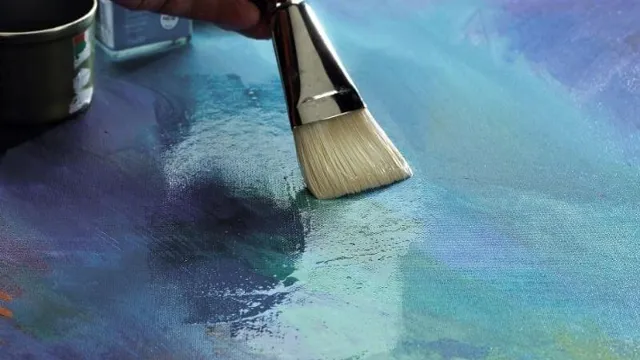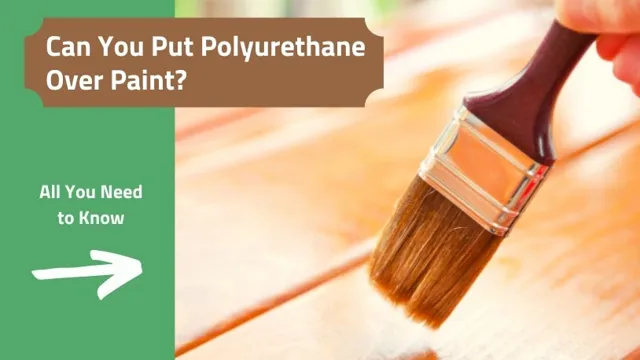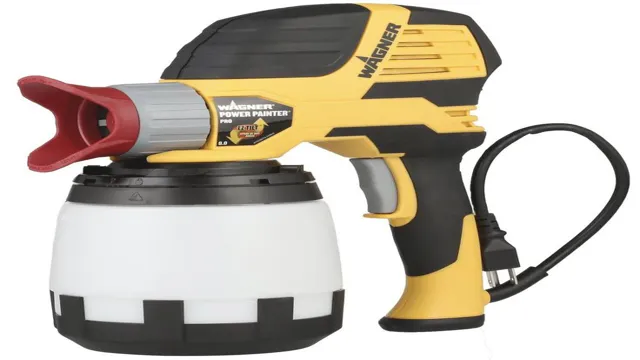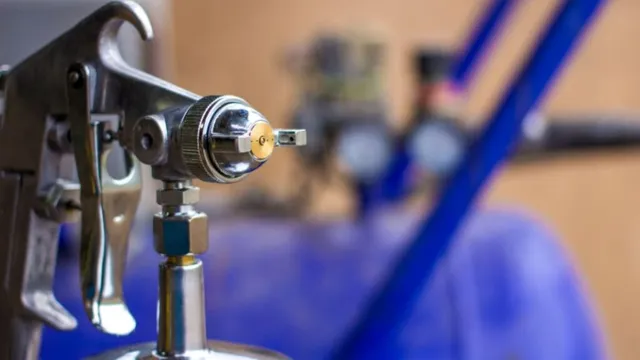Can You Put Polyurethane in a Paint Sprayer? Tips for Successful Application.

If you’re looking to give your furniture or woodworking projects a long-lasting finish, then spraying polyurethane may be the way to go. But where do you start? What equipment do you need? And what are the dos and don’ts of this particular method? Fear not, as we’re here to guide you through the process step by step. Spraying polyurethane is a popular method as it’s easy to apply and provides a smooth, even finish.
It’s also great for covering large surfaces, such as floors or cabinets. However, it can be difficult to obtain the desired result if you’re not familiar with the process. That’s why we’ve created this ultimate guide to help you achieve a flawless application.
In this guide, we’ll cover all the basics, from the different types of polyurethane to the necessary equipment you’ll need. We’ll also provide a useful list of tips and tricks to ensure you avoid any common errors. By the time you’ve finished reading, you’ll be an expert in spraying polyurethane and achieve the desired finish every time.
So why wait? Dive into the world of spraying polyurethane and create beautiful, long-lasting finishes on all of your favorite woodworking projects. With our guidance, you’ll master this technique in no time and achieve professional-level results every time you set foot in your workshop.
Using Paint Sprayer for Polyurethane
Yes, you can definitely use a paint sprayer for polyurethane. In fact, using a sprayer can be a great way to achieve a smooth and even finish on your surfaces. When using a paint sprayer for polyurethane, you want to make sure that you have the right type of sprayer.
Not all paint sprayers are designed for use with this type of coating, so be sure to check the manufacturer’s recommendations before proceeding. Additionally, you will want to thin out your polyurethane first, so that it can be properly atomized by the sprayer. This will help to ensure a consistent coverage and prevent any drips or pooling.
With the right equipment and technique, using a paint sprayer for polyurethane can be a great way to achieve professional-looking results on your projects.
Pros and Cons of Using Paint Sprayer
When it comes to using a paint sprayer for polyurethane, there are both pros and cons to consider. One of the biggest advantages of using a paint sprayer for this task is the speed at which you can complete the job. You can cover a large surface area quickly and efficiently, saving you time and energy in the process.
Additionally, a paint sprayer can help ensure an even and consistent finish, which can be difficult to achieve with a brush or roller. However, there are also some downsides to using a paint sprayer. For example, they can be more difficult to clean and maintain compared to traditional tools, and they can also be more expensive to purchase upfront.
Ultimately, the decision to use a paint sprayer for polyurethane will depend on your personal preferences and needs. If efficiency and a smooth finish are top priorities for you, a paint sprayer could be a great choice.

Advantages of Using Paint Sprayer for Polyurethane Application
Polyurethane Application Spraying polyurethane with a paint sprayer is an excellent choice for several reasons. Firstly, it allows for a fast and efficient application method that produces even and consistent coverage. This means that you can quickly and easily coat large areas with minimal effort and time spent.
Additionally, using a paint sprayer also allows for greater control over the thickness of the coating, ensuring a more even finish. Furthermore, spraying polyurethane with a paint sprayer also allows for better adhesion to surfaces, resulting in a more durable and long-lasting finish. Overall, using a paint sprayer for polyurethane application offers a range of benefits, making it a great choice for both professional and DIY projects.
So if you’re looking for an efficient and effective method for coating surfaces with polyurethane, then using a paint sprayer is definitely worth considering.
Disadvantages of Using Paint Sprayer for Polyurethane Application
While paint sprayers can be a great tool for quickly and efficiently applying paint to large surfaces, they may not be the best choice for polyurethane application. One of the disadvantages of using a paint sprayer for polyurethane is that it can be difficult to get an even coat. Polyurethane is thicker than paint, and if the sprayer is not adjusted properly, it may result in a thick coat in some areas and a thin coat in others.
This can lead to an uneven finish that looks unprofessional. Another disadvantage is the amount of overspray that occurs. Polyurethane sprays create more overspray than paint sprays, so it can be more difficult to control where the product lands.
This can result in wasted material, as well as a mess to clean up. Ultimately, if you want a smooth, even coat of polyurethane, it may be best to use a brush or roller rather than a sprayer.
Types of Polyurethane for Spray Application
Yes, you can definitely put polyurethane in a paint sprayer, but the type of polyurethane you use will depend on the specific application you have in mind. There are two main types of polyurethane for spray application: oil-based and water-based. Oil-based polyurethane produces a hard, durable finish that’s resistant to scratches, dents, and fading.
It’s ideal for surfaces that get a lot of use, like floors, stairs, and cabinets. However, oil-based polyurethane has a longer drying time and emits a strong odor, which can be overwhelming for some people. Water-based polyurethane, on the other hand, dries quickly, has a low odor, and is eco-friendly.
It’s ideal for indoor furniture and other items that don’t get a lot of wear and tear. So, before you put polyurethane in your paint sprayer, consider the application and choose the right type for the job.
Water-based Polyurethane
Water-based Polyurethane When it comes to spray application, there are various types of polyurethane available in the market. One of the most popular options is water-based polyurethane, which offers many benefits over its oil-based counterparts. Water-based polyurethane dries faster and has a lower odor and fewer VOC emissions, making it an eco-friendlier choice.
It is also more durable and resistant to yellowing compared to oil-based polyurethane. However, it is important to note that water-based polyurethane is less forgiving and requires more coats to achieve the desired finish. While it may take more time to apply, the end result is worth it in terms of longevity and sustainability.
Overall, water-based polyurethane is an excellent choice for those who want a durable, eco-friendly, and low-odor finish that requires minimal maintenance.
Oil-based Polyurethane
When it comes to choosing the right type of polyurethane for spray application, there are a few options to consider. One popular choice is oil-based polyurethane, which offers a durable finish and excellent resistance to scratches and stains. This type of polyurethane is great for high-traffic areas, as it can provide long-lasting protection for your floors or furniture.
However, one drawback of oil-based polyurethane is that it can take longer to dry and can be more difficult to clean up than other types of polyurethane. But overall, if you’re looking for a strong, durable finish for your project, oil-based polyurethane may be the way to go.
Preparing Your Paint Sprayer for Polyurethane
If you’re wondering whether you can put polyurethane in a paint sprayer, the answer is yes! However, before you do so, it’s important to prepare your paint sprayer properly. First, you’ll want to choose the right type of sprayer tip for polyurethane. A smaller tip size is recommended to prevent clogging and achieve a smoother finish.
Next, you’ll need to dilute your polyurethane with an appropriate solvent, such as mineral spirits or paint thinner, as it tends to be thicker than regular paint. Be sure to check the manufacturer’s instructions for the recommended ratio of solvent to polyurethane. Before spraying, you should also strain your polyurethane to remove any impurities that could affect the finish.
With these steps, you can rest assured that your paint sprayer is ready to handle polyurethane and achieve a flawless finish on your project. So, don’t hesitate to give it a try!
Cleaning the Paint Sprayer
Preparing your paint sprayer for polyurethane can be a daunting task, but cleaning your paint sprayer afterwards is equally important. Neglecting this step can lead to build-up and clogs that may render your spray gun useless. To properly clean your paint sprayer after spraying polyurethane, first, you need to empty any remaining liquid in the container and disassemble the gun.
Soak the disassembled parts in a cleaning solution and use a brush to scrub away any stubborn residue. Once all the parts are clean, rinse them with water and dry them thoroughly before reassembling the gun. Proper cleaning and maintenance of your paint sprayer will ensure its longevity and quality of spray for future projects.
So, take the necessary time to thoroughly clean your paint sprayer after using polyurethane to avoid any issues the next time you need to use it.
Choosing the Right Tip and Pressure
Preparing your paint sprayer for polyurethane requires choosing the right tip and pressure. Polyurethane is a thick material that requires a larger tip size and higher pressure than most paints. Choosing the correct nozzle size for the polyurethane you are using is crucial to achieving a smooth, even coat.
A nozzle size of .017 to .023 is recommended for most polyurethane coatings.
Additionally, the paint sprayer pressure should be set to the manufacturer’s recommended level for polyurethane application. Using too high or too low of a pressure can result in an uneven finish or overspray. By selecting the appropriate tip and pressure settings for your paint sprayer, you can ensure a successful polyurethane application with a professional-looking outcome.
Tips for Spraying Polyurethane
If you’re wondering if you can put polyurethane in a paint sprayer, the answer is yes, you can! However, it comes with a few caveats. First, make sure you’re using the correct type of sprayer – an airless sprayer is preferred as polyurethane is thicker than regular paint and requires a high-pressure setting. Next, you’ll want to make sure you properly thin the polyurethane – a good rule of thumb is 10% to 15% with mineral spirits.
Before you begin spraying, test it out on a piece of scrap wood to ensure you have the right consistency. Remember to keep the sprayer nozzle perpendicular to the surface and use a sweeping motion to ensure even coverage. Clean your sprayer thoroughly after each use with the appropriate solvent.
With these tips in mind, you can achieve a flawless finish with your polyurethane spray.
Spraying Techniques
Polyurethane spray is a popular method for coating wood furniture and other surfaces, especially when a smooth, glossy finish is desired. But achieving a perfect finish with polyurethane spray can be a bit challenging, especially if you are new to spraying techniques. Here are a few tips to keep in mind when spraying polyurethane.
Firstly, always test your spray on a small, inconspicuous area first to ensure that you have the right spray pressure and speed. Secondly, make sure that you are spraying in a well-ventilated area with good airflow to avoid fumes and dust settling on the surface. Thirdly, use light and even strokes to avoid drips and runs, and don’t try to cover the entire surface in one pass.
Finally, give your sprayed surface ample time to dry before applying another coat or handling the item. With these tips, you can achieve a smooth and professional finish with polyurethane spray on your wooden surfaces.
Maintaining Right Distance and Speed
Polyurethane spraying can be a tricky task, and maintaining the right distance and speed is key to achieving a flawless finish. When spraying polyurethane, it is important to keep the spray gun at a consistent distance from the surface being sprayed. As a general rule of thumb, a distance of six to eight inches usually works best.
Keep in mind that if the gun is too close, the finish may look patchy, while too far away can result in an uneven coat. In addition to distance, speed is crucial too. Start spraying before moving the gun and then continue to move it in a steady back-and-forth motion.
If you move too quickly, the coat may be too thin, and if you move too slowly, it may become too thick and lead to runs or drips. Remember, practice makes perfect, so if you’re new to polyurethane spraying, start with small test areas before moving on to larger projects. By following these tips, you can achieve a smooth and professional-looking finish that will last for years.
Conclusion
In conclusion, asking if you can put polyurethane in a paint sprayer is a bit like asking if you can use a stapler to sew a button on a shirt. Sure, it might technically work, but it’s not the best or most efficient method. Unless you’re a DIY daredevil with a love for experimentation, it’s probably best to stick to using a sprayer designed specifically for polyurethane.
Your projects (and sanity) will thank you.”
FAQs
What is polyurethane and why is it used?
Polyurethane is a type of polymer that is used to create a protective coating for various surfaces. It is commonly used in woodworking to seal and protect furniture and other wooden surfaces from damage.
Can you apply polyurethane with a paint sprayer?
Yes, you can apply polyurethane with a paint sprayer. However, it is important to choose the appropriate type of sprayer for the specific product and follow the manufacturer’s instructions.
How many coats of polyurethane should you apply?
It is recommended to apply 2-3 coats of polyurethane for maximum protection and durability. However, the exact number of coats may vary depending on the specific product and the surface being coated.
What is the difference between oil-based and water-based polyurethane?
Oil-based polyurethane is known for its durability and resistance to wear and tear, but it can take longer to dry and emits strong fumes. Water-based polyurethane, on the other hand, dries faster and emits fewer fumes but is generally less durable.
Can you mix polyurethane with other products like paint or stain?
It is not recommended to mix polyurethane with other products, as this can compromise its effectiveness and lead to an uneven finish. Instead, it is best to use each product separately and follow the manufacturer’s instructions for best results.
How long should polyurethane dry before applying another coat?
The drying time for polyurethane can vary depending on the product and conditions, but it is generally recommended to wait at least 2-4 hours before applying another coat.
How do you clean a paint sprayer after using polyurethane?
It is important to clean your paint sprayer thoroughly after using polyurethane to prevent clogging and ensure optimal performance. Follow the manufacturer’s instructions for cleaning, which may involve running cleaning solution through the sprayer and disassembling and cleaning individual parts.



